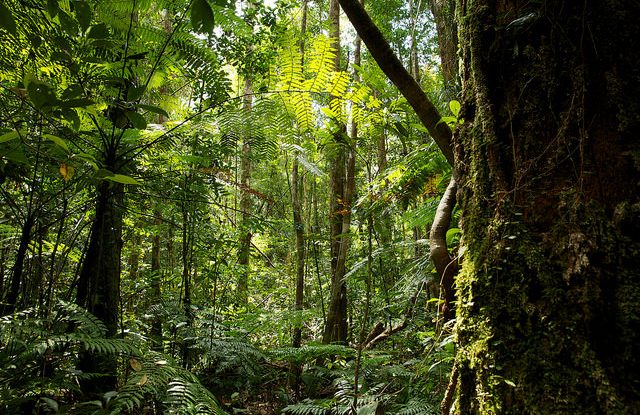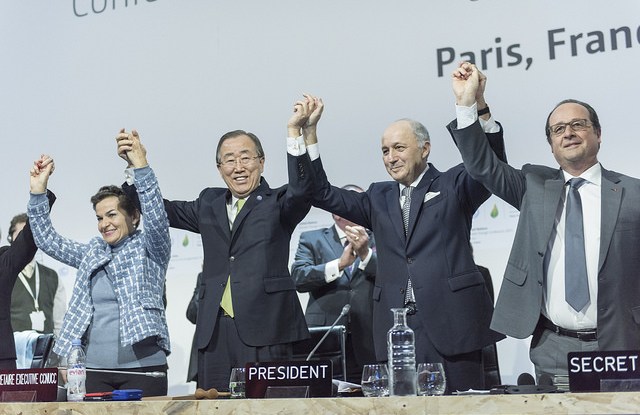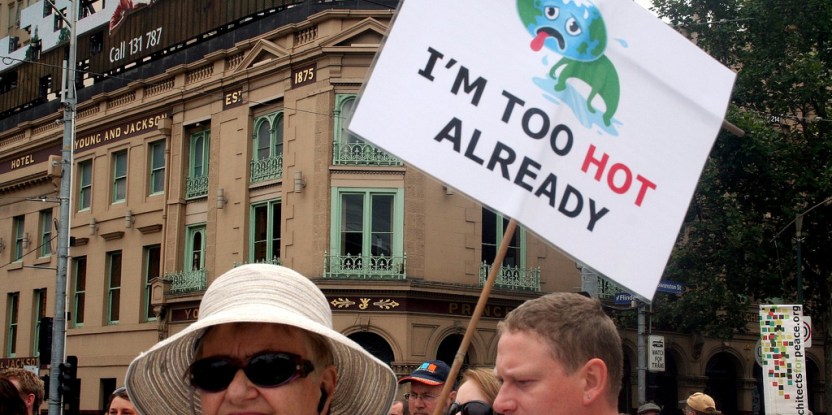The new climate deal may not be perfect, but embedded in it is guidance on how to undertake climate actions while ensuring socially and ecologically sustainable outcomes.
The Paris Agreement, which was completed on December 12, 2015 after years of negotiations among 196 countries, is indeed historic. It not only mandates limiting global temperature rise to 1.5 degrees Celsius above pre-industrial levels – well below the original 2 degree goal – it calls for the protection of indigenous land rights and ecosystem health.
Examples of harmful climate actions are identified in our briefing paper, Ensuring the right climate actions for ecosystems and people: Recommendations for Paris, prepared by the REDD+ Safeguards Working Group (RSWG), a North-South coalition of more than 40 human rights, environmental and indigenous organizations pushing for the effective implementation of REDD+ safeguards.
We describe climate actions as “wrong” when they reduce greenhouse gas emissions but, while doing so, pose threats to the lives and livelihoods of indigenous peoples and local communities, and adversely impact the ecosystems we all depend on. These actions do more harm than good and do not provide reliable, long-term solutions to climate change.
SHORT-SIGHTED SOLUTIONS
Take, for instance, large-scale bioenergy with carbon capture and storage (BECCS), a geoengineering technology that generates power by growing significant amounts of biomass, burning it, and then storing the carbon underground. BECCS is being promoted as a means to achieve negative emissions whereby more greenhouse gases are taken out of the atmosphere than are put into it.
But BECCS is also described as an elephant in the climate mitigation room, criticized both as a false and unproven solution to reduce emissions and for the risks it poses to ecosystems, indigenous peoples and local communities through the potential for land grabbing and human rights abuses.
Other wrong climate actions that have caused ecological damage include afforestation, the construction of hydropower and irrigation dams, and activities to meet bioenergy demand. In many cases, concerned communities, indigenous peoples and other stakeholders have not been consulted.
In India, for example, monoculture eucalyptus was grown over 3500 hectares with only limited community consultation. As a result, groundwater levels were depleted and critical soil nutrients lost.
In Guatemala, a hydropower project sparked violent protests among Maya Q’eqchi´ and Poqomchí indigenous tribes; it was allegedly approved without their free, prior and informed consent.
In Europe, incentives for biofuels spurred the expansion of maize plantations in Germany, reducing grasslands and peatlands, while in the United States, maize production has affected biocontrol services, resulting in a US$58 million loss for soybean producers.
Can the Paris Agreement help to prevent these “wrong” climate actions? The answer is yes, as long as countries interpret the Agreement and develop its guidelines and procedures for implementation in the “right” way.
INCLUSION OR EXCLUSION?
The Agreement introduced a set of principles to guide climate actions in its Preamble. In particular, the Preamble states that countries should, “respect, promote and consider their respective obligations on human rights, the right to health, the rights of indigenous peoples, local communities, migrants, children, persons with disabilities and people in vulnerable situations and the right to development, as well as gender equality, empowerment of women and intergenerational equity.”
The Agreement also recognizes the “importance of the conservation and enhancement, as appropriate, of sinks and reservoirs of the greenhouse gases referred to in the Convention” and notes “the importance of ensuring the integrity of all ecosystems, including oceans, and the protection of biodiversity … when taking action to address climate change.”
Some are disappointed that references to human rights and ecosystem integrity are not included in the operative text. Here, we need to explain how these provisions found their way into the Agreement.
When the two-week negotiations in Paris started on November 30, both concepts were included in the Preamble and in Article 2.2 (Purpose) of the draft agreement. Since the 2014 Lima meeting of the Conference of the Parties, the Philippines had been pushing hard for the inclusion of human rights, the rights of indigenous peoples, and ecosystem integrity in the Paris Agreement.
At an intersessional meeting in Geneva in February 2015, provisions on human rights and the rights of indigenous peoples were incorporated in the negotiating text, but ecosystem integrity was omitted in relation to mitigation actions (with text inserted only in the adaptation section). Intensive advocacy by the RSWG in subsequent meetings finally led to the reintroduction of text on ecosystem integrity in October 2015 from a submission by the Philippines. The Philippines also intervened to reinstate text that had been omitted on indigenous peoples’ rights.
Meanwhile, the small group of countries initially supporting the Philippines had grown, and the RSWG joined other civil society coalitions in a coordinated effort across constituencies. This led to the development of consolidated text (inserted into the Paris Agreement by the Philippines) and a division of labor backed by mutual support to maximize the efficiency and effectiveness of civil society advocacy on rights and ecosystems.
CLOSE CALL
In Paris, the RSWG worked hard to keep the critical provisions in place and saw crucial support from Mexico (which took the lead on human rights, forming a Friends of the Principles group) as well as from Costa Rica, Chile, Brazil, Tuvalu and Indonesia. A crisis in the first week saw the language on ecosystem integrity dropped from the text proposed by the co-facilitators of the spin-off group, while human rights was removed from Article 2.2 (Purpose), left only in the Preamble. The Philippines and Turkey intervened to restore the language on ecosystem integrity in the Preamble, while Mexico made sure we were able to preserve the gains on human rights.
The coming years will be a test of countries’ will to ensure the “revolutionary Preamble” effects real change
We in RSWG continued to campaign hard for the inclusion of ecosystem integrity, human rights and the rights of indigenous peoples in the operational part of the text. We stressed that 1.5 degrees Celsius would be difficult, if not impossible, to achieve without ecosystem integrity. We reminded negotiators that the UN Framework Convention on Climate Change contains many provisions on ecosystems, including in the Objective (Article 2) and the Commitments (Article 4). We emphasized that inclusion of ecosystem integrity in the Preamble is not enough, and would be a backsliding from the Convention itself.
In the second week of the Paris meeting, COP president Laurent Fabius announced the creation of new informal consultation groups, including one on the Preamble facilitated by Claudia Salerno, Venezuela’s lead climate negotiator. As talks entered their final days, under heavy pressure from the civil society inter-constituency group and the Friends of Principles, countries mustered political will, resulting in what Ambassador Salerno described as “a revolutionary Preamble”.
GUIDING PRINCIPLES
It provides clear social and ecological framing for all climate actions taken under the Paris Agreement, and represents a powerful set of guiding principles for climate actions that send a strong signal which cannot be ignored. The Agreement also provides for the development of guidelines and procedures over the next five years, opening the door for the adoption of further social and ecological protections when the Agreement enters into force.
Why is this revolutionary?
First, human rights, the rights of indigenous peoples and ecosystem integrity were not included in the 1992 Convention or the Kyoto Protocol. Now we have an agreement that affords them a clear role in battling climate change.
Further, the new climate deal tasks countries to ensure the integrity of all ecosystems, including oceans, and to protect biodiversity when taking action on climate change. This finds stronger and solid footing in Article 5.1, which states, “Parties should take action to conserve and enhance, as appropriate, sinks and reservoirs of greenhouse gases” (i.e. “biomass, forests and oceans, and other terrestrial, coastal and marine ecosystems”).
When taken together with the Preamble, the Agreement states loud and clear that all countries, both developing and developed, are mandated to conserve and enhance the integrity of ecosystems in a way that also respects human rights and the rights of indigenous peoples and protects biodiversity.
A ROLE FOR REDD+
This is complemented and reinforced by the inclusion of REDD+ in the Paris Agreement.
When REDD+ was first introduced in 2005, it only addressed incentivizing developing countries to reduce emissions from deforestation and forest degradation, but the RSWG along with other civil society groups worked hard to ensure that countries would establish a system to report on the implementation of REDD+ safeguards before they could receive results-based payments. REDD+ safeguards are measures that aim to minimize the possible negative effects of REDD+ activities on indigenous peoples and forest-dependent communities and on biodiversity, to achieve positive outcomes.
These safeguards were enshrined in the decision that came out of the 2010 climate change talks in Cancun, Mexico. In 2013 in Warsaw, Poland, a significant victory was achieved with a requirement for countries to provide a summary report on their implementation of REDD+ safeguards before they could obtain results-based finance.
Thus, the integration of REDD+ in the Paris Agreement provides a precedent for the development of safeguards in the Sustainable Development Mechanism (SDM), a new mitigation instrument introduced in the climate change deal. This would be a critical improvement on the Clean Development Mechanism (CDM) in the Kyoto Protocol, which does not include safeguards.
An opportunity now exists to develop progressive, comprehensive and rights-based rules, modalities and procedures for the SDM. Countries must seize this opportunity, and act on the stipulation in the Paris Agreement that the SDM rules have to be based on lessons from “existing mechanisms and approaches.” The SDM will greatly benefit from the lessons and experiences of implementing the CDM (without safeguards), and developing and implementing REDD+ (with safeguards).
The next step in the negotiations will set the stage for countries to give substance to the Paris Agreement’s references to the protection of human rights, the rights of indigenous peoples and ecosystem integrity.
The coming years will be a test of countries’ will to ensure the ‘revolutionary Preamble’ effects real change. We have the right signal from the Paris Agreement; with global resolve and political will, we can work together to turn this signal into effective climate actions.
Note: The authors are affiliated with the Ateneo de Manila University School of Government, which serves as the secretariat of the RSWG. La Viña and Romero were also civil society members of the official delegation of the Philippines in Paris. However, in no way should the statements in this article be considered as an official position of the Philippines.
We want you to share Forests News content, which is licensed under Creative Commons Attribution-NonCommercial-ShareAlike 4.0 International (CC BY-NC-SA 4.0). This means you are free to redistribute our material for non-commercial purposes. All we ask is that you give Forests News appropriate credit and link to the original Forests News content, indicate if changes were made, and distribute your contributions under the same Creative Commons license. You must notify Forests News if you repost, reprint or reuse our materials by contacting forestsnews@cifor-icraf.org.




